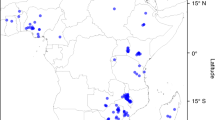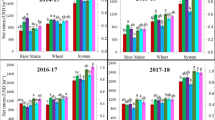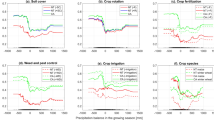Abstract
Agriculture’s contribution to the Sustainable Development Goals requires climate-smart and profitable farm innovations. In the past decade, attention has been given to conservation agriculture as a ‘sustainable intensification’ strategy, although a lack of evidence-based consensus on the merits of conservation agriculture prevails in the context of intensive smallholder farming in South Asia. A meta-analysis using 9,686 paired site–year comparisons representing different indicators of cropping-system performance suggest significant (P < 0.05) benefits when conservation-agriculture component practices are implemented either separately or in tandem. For example, zero tillage with residue retention had a mean yield advantage of 5.8%, a water use efficiency increase of 12.6%, an increase in net economic return of 25.9% and a reduction of 12–33% in global warming potential, with more-favourable responses on loamy soils and in maize–wheat systems. Results suggest that there are opportunities to maximize expected benefits, and policymakers and development practitioners should continue to be appraised of the potential of CA for contributing to the Sustainable Development Goals in South Asia.
This is a preview of subscription content, access via your institution
Access options
Access Nature and 54 other Nature Portfolio journals
Get Nature+, our best-value online-access subscription
$29.99 / 30 days
cancel any time
Subscribe to this journal
Receive 12 digital issues and online access to articles
$119.00 per year
only $9.92 per issue
Buy this article
- Purchase on Springer Link
- Instant access to full article PDF
Prices may be subject to local taxes which are calculated during checkout



Similar content being viewed by others
Data availability
The data that support the findings of this study are available on request from the corresponding author on a case-by-case basis. The on-station data sources have been listed in the Supplementary Information. Source Data for Figs. 1–3 are provided as Source Data files.
Code availability
The reproducible code for the analyses is available at https://github.com/wviechtb/metafor; common code for generating figures is available at https://ggplot2.tidyverse.org/.
References
Hattleback, M. Malnutrition in South-Asia. Poverty, Diet or Lack of Female Empowerment? CMI Working Pap. Wp. 4, 14 (CMI, 2012).
The Future of Food and Agriculture: Trends and Challenges (FAO, 2017).
Amarnath, G., Alahacoon, N., Smakhtin, V. & Aggarwal, P. Mapping Multiple Climate-Related Hazards in South Asia Research Report 170 (IWMI, 2017).
Muthukumara, M., Bandyopadhyay, S., Chonabayashi, S., Markandya, A. & Mosier, T. South Asia’s Hotspots: Impacts of Temperature and Precipitation Changes on Living Standards (World Bank, 2018).
Tilman, D., Balzer, C., Hill, J. & Befort, B. L. Global food demand and the sustainable intensification of agriculture. Proc. Natl Acad. Sci. USA 108, 20260–20264 (2011).
Godfray, H. C. J. & Garnett, T. Food security and sustainable intensification. Phil. Trans. R. Soc. B 369, 20120273 (2014).
What Is Conservation Agriculture? (FAO, 2014).
Giller, K., Witter, E., Corbeels, M. & Tittinell, P. A. Conservation agriculture and smallholder farming in Africa: the heretics’ view. Field Crops Res. 114, 23–24 (2009).
Rusinamhodzi, L. et al. A meta-analysis of long-term effects of maize grain yield under rain-fed conditions. Agron. Sust. Dev. 31, 657–673 (2011).
Friedrich, T., Derpsch, R. & Kassam, A. Overview of the global spread of conservation agriculture. Field Actions Sci. Rep. 6 (Special issue), 1–7 (2012).
Jat, M. L. et al. (eds) Proc. Regional Dialogue on Conservation Agriculture in South Asia (CIMMYT; APAARI; ICAR, 2012).
Brouder, S. M. & Gomez-Macpherson, H. The impact of conservation agriculture on smallholder agricultural yields: a scoping review of the evidence. Agric. Ecosyst. Environ. 187, 11–32 (2014).
Palm, C., Bnalco-Canqui, H., Declerck, F., Gatere, L. & Grace, P. Conservation agriculture and ecosystem services: an overview. Agric. Ecosyst. Environ. 187, 87–105 (2014).
Pittelkow, C. M. et al. Productivity limits and potentials of the principles of conservation agriculture. Nature 517, 365–368 (2015).
Harrington, L. W. & Hobbs, P. H. in Integrated Crop and Resource Management in the Rice–Wheat System of South Asia (eds Ladha, J. K. et al.) 3–67 (ADB, 2009).
Kiel, A., D’Souza, A. & McDonald, A. Growing the service economy for sustainable wheat intensification in the Eastern Indo-Gangetic Plains: lessons from custom hiring services for zero-tillage. Food Secur. 8, 1011–1028 (2016).
Erenstein, O. & Laxmi, V. Zero tillage impacts in India’s rice–wheat systems: a review. Soil Tillage Res. 100, 1–14 (2008).
Ladha, J. K. et al. in Integrated Crop and Resource Management in the Rice–Wheat System of South Asia (eds Ladha, J. K. et al.) 69–108 (ADB, 2009).
Huang, Y. et al. Greenhouse gas emissions and crop yield in no-tillage systems: a meta-analysis. Agric. Ecosyst. Environ. 268, 144–153 (2018).
Van den Putte, A., Govers, G., Diels, J., Gillijns, K. & Demuzere, M. Assessing the effect of soil tillage on crop growth: a meta-regression analysis on European crop yields under conservation agriculture. Eur. J. Agron. 33, 231–241 (2010).
Jat, R. K. et al. Ten years of conservation agriculture in a rice–maize rotation of Eastern Gangetic Plains of India: yield trends, water productivity and economic profitability. Field Crop. Res. 232, 1–10 (2019).
Gathala, M. K. et al. Effect of tillage and crop establishment methods on soil physical properties of a medium-textured soil under a seven-year rice–wheat rotation. Soil Sci. Soc. Am. J. 75, 1851–1862 (2011).
Jat, R. D. et al. Conservation agriculture and precision nutrient management practices in maize–wheat system in North-West IGP: effects on crop and water productivity and economic profitability. Field Crops Res. 218, 33–50 (2018).
Kumar, V. & Ladha, J. K. Direct seeding of rice. Recent developments and future research needs. Adv. Agron. 111, 297–413 (2011).
Chakraborty, D. et al. A global analysis of alternative tillage and crop establishment practices for economically and environmentally efficient rice production. Sci. Rep. 7, 9342 (2017).
Pittelkow, K. M. et al. When does no-till yield more? A global meta-analysis. Field Crops Res. 183, 156–168 (2015).
Shyamsundar, P. et al. Fields on fire: alternatives to crop residue burning in India. Science 365, 536–538 (2019).
Sidhu, H. S. et al. Development and evaluation of Turbo Happy Seeder to enable efficient sowing of wheat into heavy crop rice residue in rice–wheat rotation in the IGP of NW India. Field Crops Res. 184, 201–212 (2015).
Shyamsundar, P. Can India’s farmers deliver clean air along with good food? Cool Green Science https://go.nature.com/3aJkWUT (2017).
Aryal, J. P. et al. Conservation agriculture-based wheat production better copes with extreme climate events than conventional tillage-based systems: a case of untimely excess rainfall in Haryana, India. Agric. Ecosyst. Environ. 233, 325–335 (2016).
Jat, M. L. in Agriculture under Climate Change: Threats, Strategies and Policies (eds Belavadi, V. V., Nataraja Karaba, N. & Gangadharappa, N. R.) 147–154 (Allied Publishers Pvt. Ltd., 2017).
Singh, Yadvinder et al. Nitrogen management for zero till wheat with surface retention of rice residues in north-west India. Field Crops Res. 184, 183–191 (2015).
Sidhu, H. S. et al. Sub-surface drip fertigation with conservation agriculture in a rice-wheat system: a breakthrough for addressing water and nitrogen use efficiency. Agric. Water Manag. 216, 273–283 (2019).
Groot, A. E. et al. Business models of SMEs as a mechanism for scaling climate smart technologies: the case of Punjab, India. J. Clean. Prod. 210, 1109–1119 (2019).
Alam, M. M. et al. Improvement of cereal-based cropping systems following the principles of conservation agriculture under changing agricultural scenarios in Bangladesh. Field Crop Res. 175, 1–15 (2015).
Kirkegaard, J. A. et al. Sense and nonsense in conservation agriculture: principles, pragmatism and productivity in Australian mixed farming systems. Agric. Ecosyst. Environ. 187, 133–145 (2014).
Ladha, J. K. et al. Agronomic improvements can make future cereal systems in South Asia far more productive and result in a lower environmental footprint. Glob. Change Biol. 22, 1054–1074 (2016).
Seth, A., Fischer, K., Anderson, J. & Jha, D. The Rice-Wheat Consortium: An Institutional Innovation in International Agricultural Research on the Rice–Wheat Cropping Systems of the Indo-Gangetic Plains (IGP) The Review Panel Report (Rice-Wheat Consortium, 2003).
Gupta, R. & Seth, A. A review of resource conserving technologies for sustainable management of the rice–wheat cropping systems of the Indo-Gangetic Plains (IGP). Crop Prot. 26, 436–447 (2007).
Ladha, J. K., Pathak, H., Tirol-Padre, A., Dawe, D. & Gupta, R. K. in Improving the Productivity and Sustainability of Rice–wheat Systems: Issues and Impacts (eds Ladha et al.) 45–76 (ASA, CSA and SSSA, 2003).
Giller, K., Witter, E., Corbeels, M. & Tittinell, P. A. Conservation agriculture and smallholder farming in Africa: the heretics’ view. Field Crops Res. 114, 23–24 (2009).
Giller, K. E. et al. Beyond conservation agriculture. Front. Plant Sci. 6, 870 (2015).
Kassam, A., Friedrich, T. & Derpsch, R. Global spread of conservation agriculture. Int. J. Environ. Stud. 76, 29–51 (2018).
Ridaura, S. L. et al. Climate smart agriculture, farm household typologies and food security: an ex-ante assessment from Eastern India. Agric. Sys. 159, 57–68 (2018).
Dastane, N. G. Effective Rainfall in Irrigated Agriculture Irrigation and Drainage Paper 25 (FAO, 1974).
Hedges, L. V., Gurevitch, J. & Curtis, P. S. The meta-analysis of response ratios in experimental ecology. Ecology 80, 1150–1156 (1999).
Adams, D. C., Gurevitch, J. & Rosenberg, M. S. Resampling tests for meta‐analysis of ecological data. Ecology 78, 1277–1283 (1997).
Viechtbauer, W. Conducting meta-analyses in R with the metafor package. J. Stat. Softw. 36, 1–48 (2010).
Acknowledgements
We thank the Indian Council of Agricultural Research (ICAR), Government of India for Window 3 grant to CIMMYT, the CGIAR Research Programs on Wheat Agri-Food Systems (CRP WHEAT) and Climate Change, Agriculture and Food Security (CCAFS) for funding this research. CCAFS’s work is supported by CGIAR Fund Donors and through bilateral funding agreements. For details, please visit https://ccafs.cgiar.org/donors. Any opinions, findings, conclusions, or recommendations expressed in this publication are those of the authors and do not necessarily reflect the view of the associated and/or supporting institutions/funders. The usual disclaimer applies.
Author information
Authors and Affiliations
Contributions
M.L.J. conceptualized, designed and coordinated the work. M.L.J., D.C., M.K.G. and D.S.R. acquired the data. D.C. and D.S.R. analysed the data and interpreted results. J.K.L. supervised and drafted the work, interpreted results and revised the manuscript. A.M. and B.G. interpreted results and revised the manuscript.
Corresponding author
Ethics declarations
Competing interests
The authors declare no competing interests.
Additional information
Publisher’s note Springer Nature remains neutral with regard to jurisdictional claims in published maps and institutional affiliations.
Supplementary information
Supplementary Information
Supplementary methods, results, Tables 1–10, Figs. 1 and 2, note and references.
Source data
Source Data Fig. 1
Statistical Source Data
Source Data Fig. 2
Statistical Source Data
Source Data Fig. 3
Statistical Source Data
Rights and permissions
About this article
Cite this article
Jat, M.L., Chakraborty, D., Ladha, J.K. et al. Conservation agriculture for sustainable intensification in South Asia. Nat Sustain 3, 336–343 (2020). https://doi.org/10.1038/s41893-020-0500-2
Received:
Accepted:
Published:
Issue Date:
DOI: https://doi.org/10.1038/s41893-020-0500-2
This article is cited by
-
Economy-wide impact of climate smart agriculture in India: a SAM framework
Journal of Economic Structures (2024)
-
Comparative analysis of soil quality and enzymatic activities under different tillage based nutrient management practices in soybean–wheat cropping sequence in Vertisols
Scientific Reports (2024)
-
Evaluating the potential and eligibility of conservation agriculture practices for carbon credits
Scientific Reports (2024)
-
Agricultural management practices in China enhance nitrogen sustainability and benefit human health
Nature Food (2024)
-
Climate-smart agriculture (CSA) adaptation, adaptation determinants and extension services synergies: a systematic review
Mitigation and Adaptation Strategies for Global Change (2024)



